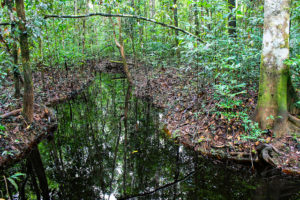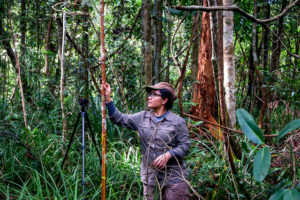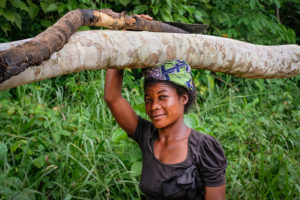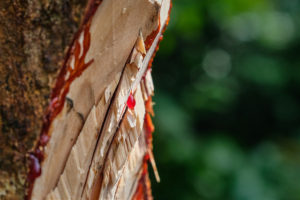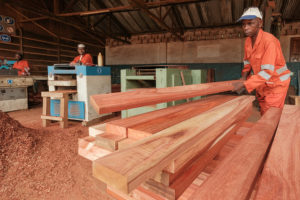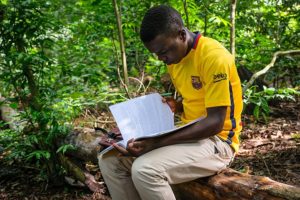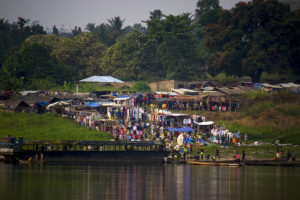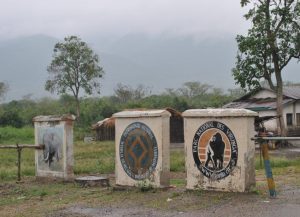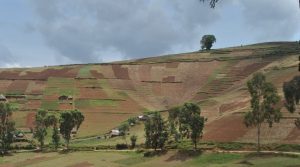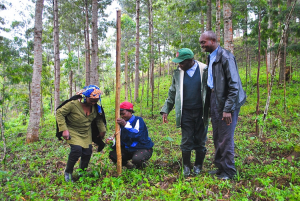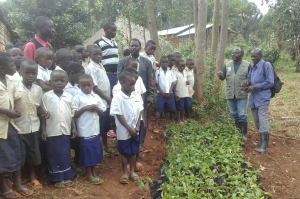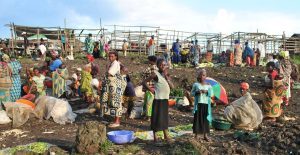Community forestry is an attractive endeavor in the quest to reduce poverty. Multiple countries with tropical forests have placed it at the heart of their rural development strategies, giving local communities the rights to directly manage forests and decide how land will be used.
Underpinning community forestry is the proven belief that local people are best placed to manage the resources on which they rely. Done sustainably, poverty can be alleviated, social mobility enhanced, and the ecological protection of the forest achieved.
But between theory and practice, lies a disconnect.
A new study shows that the benefits don’t always materialize. Community elites are most likely to reap the rewards from such models, risking disillusionment among rural communities. Such is the case of multiple community forest initiatives across Central Africa, found researchers from the Center for International Forestry Research (CIFOR) and the University of Kisangani (UNIKIS).
Scientists found that two community forest pilot sites in northeast Democratic Republic of the Congo (DRC), failed to produce an increase in people’s real income. “Our research shows that the business case for community forests in DRC remains weak,” said Guillaume Lescuyer, lead author of the study. “In both of our pilot sites, we saw a negative financial turnover over five years. All the productive activities that we analyzed – including logging, hunting and firewood collection – either result in losses or a very low profit.” The researchers therefore advise that community forestry is unlikely to develop into a profitable model in the DRC, unless people are convinced that it will increase their financial and physical capital.
Though financial impact is just one factor to consider when assessing community forests, it is arguably the biggest deciding factor for communities to maintain or discard the model.
The findings from the DRC come at a crucial moment when the Congolese authorities are backing community forestry, implementing several legal and administrative entities. “In 2002 the national forestry law adopted the concept of ‘local community forest’, but it lacked detail until 2016,” explained Ignace Muganguzi, co-author of the study.
“Recently this law has been complimented by a series of decrees that are opening a legal pathway to formalize community forests of up to 50,000 hectares.”
The Ministry of Environment and Sustainable Development has also created a sub-department devoted to community forestry, while there is a new government-wide National Strategy for Community Forestry aimed at promoting this model.
Read also: Setting the stage for agroforestry expansion in Eastern Congo
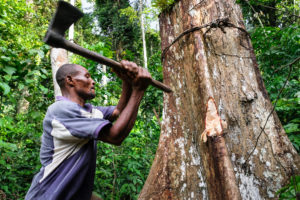
Financial failures
Despite the recent rise of community forestry in the DRC, one of the barriers that persists is the exorbitant costs required to set up a community forest. In the selected case studies, USD 100,000 to USD 160,000 is needed to comply with regulations. These fees cover necessary coordination meetings and committees, the creation of boundary lines and maps, baseline studies, and other formal procedures. “The start-up cost is just too high to make this model viable,” stated Lescuyer.
Beyond these expenses, lies high costs of formalizing local economic activities to comply with regulatory requirements. “The payment of all the approvals, taxes and permits that are required to carry out activities such as hunting, chain-sawing, or gathering non-timber forest products, in a legal manner, often prevents small producers from making a profit,” added Lescuyer.
To address these issues, the researchers make two recommendations.
First, new community forest projects should focus on the productive uses of forest resources, creating a business case with financial forecasts. “Short and medium-term livelihood outcomes need to be quantitatively measured, and to continue supporting these projects there should be strong evidence of a significant economic impact,” said Lescuyer. The study shows that to date, no community forest in the DRC has conducted such analyses.
Second, legal constraints should be simplified to reduce the cost of creating and managing community forests. Furthermore, local institutional processes should be streamlined to facilitate operations. “If national regulations continue the same, people might even favor illegal practices to cover these costs,” warned Muganguzi.
A question of ownership
This new research underlines finance as a major obstacle to the success of community forestry in the DRC: the lack of ownership by local populations.
The researchers argue that in most cases, community forestry emerges as a top-down initiative. Because of expensive administrative costs, the creation of community forests is out of reach for local communities, making them dependent on external actors. These days, many initiatives in the DRC are thus subsidized by international funds and run by local or international NGOs. “One of the problems with this situation is that the intervening agencies tend to impose their normative values and sophisticated management tools,” explained Lescuyer. “A bottom-up approach that takes into consideration local realities of communities would be more appropriate. It could lead to more functional systems than those brought in from outside.”
A regional problem
Community forestry became a booming trend among political and technical circles across Central Africa in the 1990s. Cameroon rose as the early-adopter, being the first country in the region to enshrine it in law. The government created formal community forests as early as 1998, which allowed village associations to legally harvest, process, and trade forest resources within an area of up to 5,000 hectares.
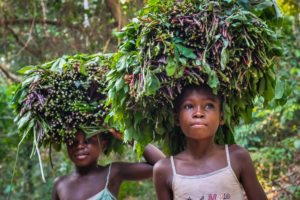
However, the limited financial impact on rural livelihoods, as well as the complicated administrative procedures, have hindered any extensions. At present, only about one percent of Cameroon’s forests is managed by the communities.
“In Cameroon, engagement in community forestry has also been very low, mainly because of the lack of belief that it will raise their standard of living,” explained Lescuyer. “Likewise, in this case the costs of setting up a community forest is too elevated.”
What’s more, previous research unearthed multiple cases where community forests in Cameroon were exploited through subcontracts with logging companies. Mostly medium-sized and informal, they paid cut-rate rents that did not trickle down to improve collective standards of living; the reality of job creation reflected by very low salaries.
Other studies have concluded that revenues from logging are seldom equally distributed- local political, economic and military elites reaping the lion share of profits.
“The failure of community forestry in Cameroon is worrying because the model has been replicated for about 15 years across Central African countries, especially in Gabon, the DRC, and Central African Republic,” said Lescuyer.
Read also: Addressing equity in community forestry: lessons from 20 years of implementation in Cameroon
The essence of community forestry
While CIFOR and UNIKIS’ research focuses on the financial returns of community forests and their impact on livelihoods, the authors acknowledge that there are benefits beyond monetary gains.
Community forests protect biodiversity, which in turn supports food security; they both mitigate and facilitate adaptation to climate change, sucking carbon from the air and retaining natural barriers against intense weather events; they are an important tool for recognizing customary rights; they help secure land tenure and facilitate long-term investment by the involved communities.
“Of course there are other long-term benefits,” recognized Lescuyer, “but so far there aren’t enough examples from Central Africa to say that community forestry can improve the well-being of people without increasing their revenues.”
Lescuyer agrees, believing that the purpose of increasing income should be at the core of community forestry, especially in rural areas where development options are limited. “It is time to ensure that the tens of millions of dollars devoted to supporting this model actually ends to alleviate poverty,” he concluded.
By Ahtziri Gonzalez, originally published at CIFOR’s Forests News.
This research was supported by the REFORCO and FORETS projects and funded by the European Union.
This work is also part of the CGIAR Research Program on Forests, Trees and Agroforestry (FTA), the world’s largest research for development program to enhance the role of forests, trees and agroforestry in sustainable development and food security and to address climate change. CIFOR leads FTA in partnership with Bioversity International, CATIE, CIRAD, ICRAF, INBAR and TBI. FTA’s work is supported by the CGIAR Trust Fund.












